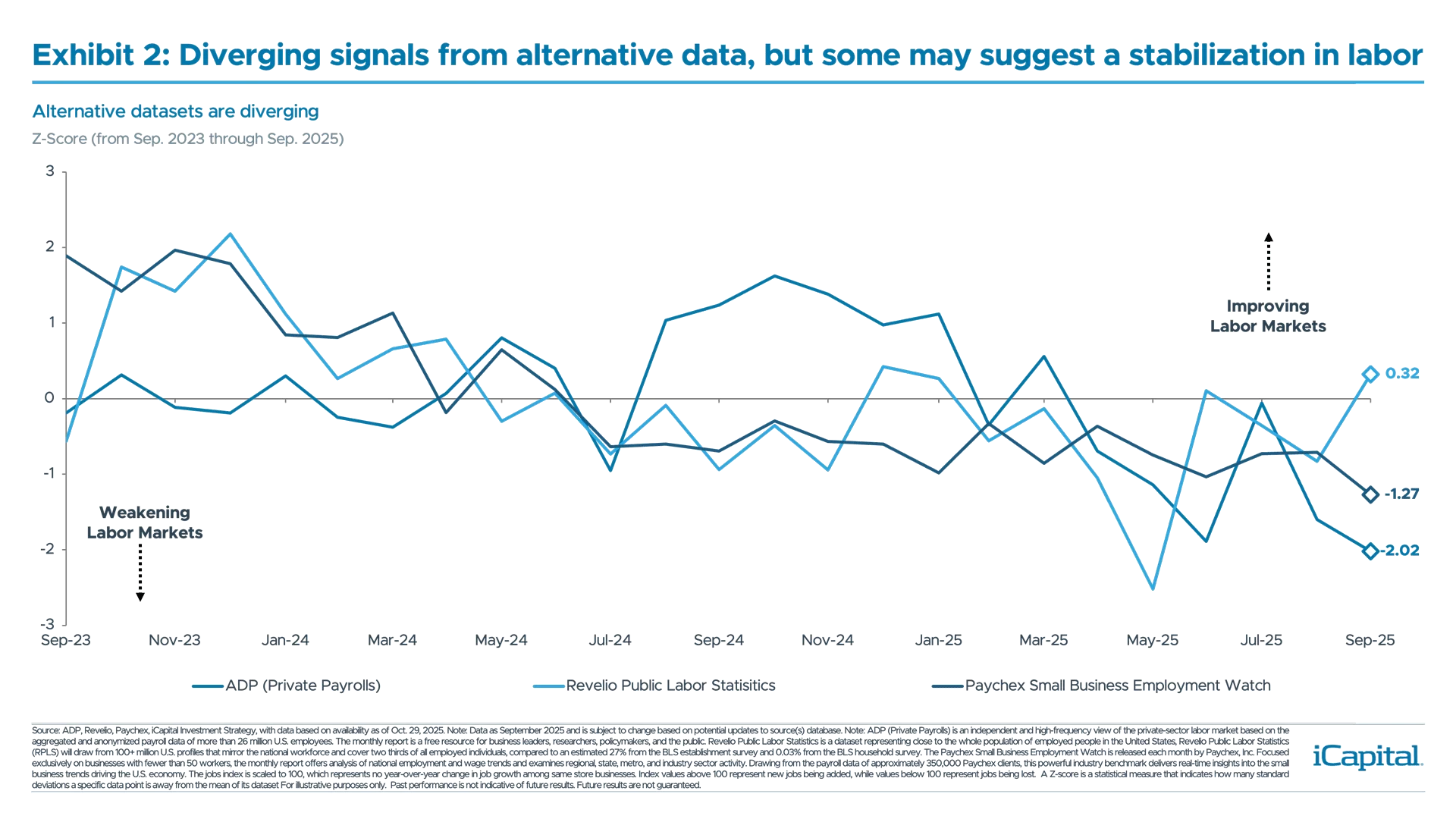Key Takeaways:
- December Rate Cut Is Uncertain: The Federal Reserve (Fed) signals a December cut isn’t guaranteed, challenging market expectations and potentially introducing policy uncertainty.
- Data Vacuum Could Fuel Volatility: The shutdown is halting key data releases, which could increase volatility around upcoming data, making signals harder to interpret.
- Mixed Signals in Labor and Inflation Data: The job market, while slowing, is starting to show signs of stabilizing. While disinflation remains intact, tariffs and food prices are key focal points.
- Liquidity Outlook Supports Risk Assets: Despite the uncertainty around upcoming data and now the potential policy path, improving liquidity conditions into 2026 supports risk assets across private and public markets.
The one big takeaway from the latest Federal Open Market (FOMC) meeting: December isn’t a lock for the next interest rate cut. While the central bank lowered interest rates by another 25 basis points (bps – or one-hundredth of a percentage point), Fed Chair Powell’s message to the market is that another reduction at the next meeting is “far from a foregone conclusion.”1
The market had been pricing in a third cut with near certainty, while also anticipating the end of quantitative tightening – which is now a reality. Yet, with the path of policy now in flux, uncertainty is likely to percolate given we are operating in a data vacuum. We could see increased volatility around economic data as the collection of nearly all federal data has been postponed during the government shutdown – calling into question the economic outlook. Given this reality, we are looking at several high-frequency or alternative datasets to help us make our assessments.
Despite the uncertainty about data and now the potential policy path, zooming out, we do believe the liquidity environment should improve into year-end and through 2026 as the run-off of the Fed’s balance sheet comes to an end. This improvement should ultimately be beneficial to risk assets in both private and public markets over the medium term.
Far From a Forgone Conclusion
The policy decision from the October FOMC meeting was largely expected—a 25 bps interest rate cut and a commitment to end the balance sheet run-off (effective December 1). However, the dissents by FOMC voting members and the Chair’s comments were a surprise to the markets.
Governor Stephen Miran continues to dissent in favor of a 50 bps cut, similar to the September FOMC. The surprising dissent was from Fed President Jeffrey Schmid, who would have preferred the Fed not adjust its policy rate. These two dissents highlight a wide divergence forming in the dot plot for this year and 2026, seen in exhibit 1.
 Uncertainty around the trajectory of policy was also called into question as Chair Powell doubled down that another cut, “was far from a forgone conclusion in December.”2 Markets moved on these comments given that a rate cut had been fully priced in for December. This now challenges the outlook for the remainder of this year and early next year as the Chair stated, “the logic for cuts going forward is different.”3
Uncertainty around the trajectory of policy was also called into question as Chair Powell doubled down that another cut, “was far from a forgone conclusion in December.”2 Markets moved on these comments given that a rate cut had been fully priced in for December. This now challenges the outlook for the remainder of this year and early next year as the Chair stated, “the logic for cuts going forward is different.”3
While it makes sense to see bond yields move higher and rate expectations come down during and after the FOMC meeting, we still believe the December meeting is very much “live.” Chair Powell also discussed during his press conference that: “available data suggest the outlook hasn’t changed.”4 While there might be some green shoots starting to form in labor data, if the trajectory hasn’t changed much, we still believe the Fed may favor bringing policy to a more neutral setting as it continues to respond to labor market weakness.
The Data Vacuum Continues, Which Could Lead to More Volatility
While the Fed ultimately cut in response to weakening labor markets, the lack of data has not only made the Fed’s job more challenging, but also investor’s ability to interpret the current state of the economy.
Despite the limited amount of data, the economy is showing signs of holding up, as seen with the S&P Global U.S. Composite Purchasing Managers’ Index (PMI) hitting a 3-month high.5 But, given there was no data collection in October (as of 10/30), this could add to the volatility around future releases. Notably, we now see challenges to October data (scheduled for release in November) if it is ultimately released.
- Seasonal Issues: If the data is collected outside the reference period, it will be hard to seasonally compare the data because the reference and survey periods will occur at different times.
- Response Rates: This has been one of the issues with economic, specifically labor, data this year. The reference periods for the November nonfarm payroll report (released in December) end on 11/8 for the household survey and 11/12 for the establishment survey.6 With no signs of the government shutdown ending, this could impact the responses and ultimately weigh on data given the potential for a smaller sample size.
What Data Are We Monitoring at This Juncture
With economic data likely to be volatile over the coming months – given seasonal issues and possibly low response rates – we believe it will be critical to look at high-frequency and alternative data to gauge how the economy is performing.
Labor:
We are currently following ADP, Paychex, Revelio and state initial jobless claims data to gauge how labor markets have been evolving during the shutdown. Currently these measures paint a mixed picture.
Both ADP and Paychex are pointing to a slowing labor market, with ADP reporting negative job growth in three out of the last four months7 and Paychex data declining by -0.31 percentage points over the last year—indicating job losses for small businesses.8 However, ADP has now released a weekly index which shows a stabilization in labor markets, showing 57K jobs created over the last month.9
On the other hand, Revelio and state claims data continues to confirm the low hire and low fire environment. The September (October release) of the Revelio Public Labor Statistics showed the labor market expanded by 60K – in line with our expectation for trend rate job growth.10 And the state claims level data would also suggest that layoffs remain low.11 However, several large corporations have recently announced job cuts. While these announcements are still small in the aggregate – Amazon was 4%12 of the corporate workforce and UPS was 6.7%13 of the operational workforce – this is a trend worth watching.
While high frequency indicators are sending mixed signals (seen in exhibit 2), we believe that we are starting to see green shoots in labor market data.
 Inflation:
Inflation:
Over the last few months, the disinflationary trend back to the Fed’s target has slowed. However, there are indications that inflation could be lower. Truflation, which produces real-time daily inflation indices, would suggest inflation should be ~2.5% year-over-year (YoY).14 In addition, the Zillow rent index is at 2.6% YoY which is below the 3.8% increase in owners’ equivalent rent (seen in exhibit 3), suggesting further disinflation in shelter cost – though there are long and variable lags.15
 While this would indicate that inflation should return to trend, we are still mindful of the pass through from tariffs and other key household items. Based on recent analysis, tariffs have contributed 20% of the 70 bps cumulative increase through the August Consumer Price Index (CPI) report.16 In addition food prices contributed ~11% to the 31 bp month-over-month increase in September.17 While these changes are important to monitor, we are reminded of the high weighting of services in CPI. Given the 60% core services make-up of the headline basket, it would take a very meaningful increase from tariffs, food and energy prices to offset the disinflationary trend.18
While this would indicate that inflation should return to trend, we are still mindful of the pass through from tariffs and other key household items. Based on recent analysis, tariffs have contributed 20% of the 70 bps cumulative increase through the August Consumer Price Index (CPI) report.16 In addition food prices contributed ~11% to the 31 bp month-over-month increase in September.17 While these changes are important to monitor, we are reminded of the high weighting of services in CPI. Given the 60% core services make-up of the headline basket, it would take a very meaningful increase from tariffs, food and energy prices to offset the disinflationary trend.18
Retail Sales:
Various measures generally point to healthy consumer spending. In fact, looking at recent credit card data, spending increased by 2.0% YoY for the month of September—up from 1.7% the prior month.19 While spending has remained healthy, there is a disconnect between the high-income consumer and the low-income consumer. Indeed, the high-income consumer saw their spending rise by 2.6% YoY, which compares to the low-income consumer at 0.6% YoY.20 While the K-shaped economy is something we are watching (discussed here), the low-income consumer, while slowing, is not outright contracting.
While consumer spending may have slowed slightly in October – a give back from the back-to-school shopping season – spending in October still appears healthy. Based on the Johnson Redbook same store sales index, it bottomed a few weeks ago and is now increasing by 5.2% YoY.21
Based on the indicators we are following, we feel like the trajectory of the economy has not meaningfully changed since the shutdown. While data might be volatile over the coming months, these are some of the indicators we will be monitoring to help us assess how the economy is evolving.
Investment Implications: Looking Through the Noise
As markets will likely reprice rate expectations for the December FOMC meeting, this could put some upward pressure on rates in the near term. Coupled with the strong rally and high valuations for equity markets, this could potentially lead to a near-term consolidation. However, we would be looking through this and would potentially add to our risk asset exposure on any pullbacks, as the outlook for the economy hasn’t changed (maybe even improved somewhat) and the liquidity environment should improve not only at the end of this year, but in 2026. All else equal, this should be a supportive environment for risk assets in both private and public markets.
END NOTES
- Federal Reserve, as of Oct. 29, 2025.
- Federal Reserve, as of Oct. 29, 2025.
- Federal Reserve, as of Oct. 29, 2025.
- Federal Reserve, as of Oct. 29, 2025.
- S&P Global, as of Oct. 24, 2025. Note: The S&P Global U.S. Composite PMI is a monthly economic indicator based on surveys of purchasing managers in the manufacturing and services sectors. It measures economic health by tracking changes in business activity, with an index above 50 indicating expansion and a reading below 50 signaling contraction.
- Bureau of Labor Statistics, as of Oct. 28, 2025.
- Automated Data Processing, as of Oct. 1, 2025.
- Paychex, as of Sep. 30, 2025.
- Automated Data Processing, as of Oct. 28, 2025.
- Revelio Labs, as of Oct. 6, 2025.
- Citi, as of Oct. 24, 2025.
- Reuters, as of Oct. 28, 2025.
- Wall Street Journal, as of Oct. 29, 2025.
- Truflation, as of Oct. 27, 2025.
- Zillow, as of Sep. 16, 2025.
- HBS Pricing Lab, as of Oct. 27, 2025.
- Bureau of Labor Statistics, iCapital Investment Strategy, as of Oct. 24, 2025.
- Bureau of Labor Statistics, as of Oct. 24, 2025.
- Bank of America, as of Oct. 10, 2025.
- Bank of America, as of Oct. 10, 2025.
- Redbook Research, as of Oct. 10, 2025.
IMPORTANT INFORMATION
The material herein has been provided to you for informational purposes only by Institutional Capital Network, Inc. (“iCapital Network”) or one of its affiliates (iCapital Network together with its affiliates, “iCapital”). This material is the property of iCapital and may not be shared without the written permission of iCapital. No part of this material may be reproduced in any form, or referred to in any other publication, without express written permission of iCapital.
This material is provided for informational purposes only and is not intended as, and may not be relied on in any manner as, legal, tax or investment advice, a recommendation, or as an offer or solicitation to buy or sell any security, financial product or instrument, or otherwise to participate in any particular trading strategy. This material does not intend to address the financial objectives, situation, or specific needs of any individual investor. You should consult your personal accounting, tax and legal advisors to understand the implications of any investment specific to your personal financial situation.
ALTERNATIVE INVESTMENTS ARE CONSIDERED COMPLEX PRODUCTS AND MAY NOT BE SUITABLE FOR ALL INVESTORS. Prospective investors should be aware that an investment in an alternative investment is speculative and involves a high degree of risk. Alternative Investments often engage in leveraging and other speculative investment practices that may increase the risk of investment loss; can be highly illiquid; may not be required to provide periodic pricing or valuation information to investors; may involve complex tax structures and delays in distributing important tax information; are not subject to the same regulatory requirements as mutual funds; and often charge high fees. There is no guarantee that an alternative investment will implement its investment strategy and/or achieve its objectives, generate profits, or avoid loss. An investment should only be considered by sophisticated investors who can afford to lose all or a substantial amount of their investment.
iCapital Markets LLC operates a platform that makes available financial products to financial professionals. In operating this platform, iCapital Markets LLC generally earns revenue based on the volume of transactions that take place in these products and would benefit by an increase in sales for these products.
The information contained herein is an opinion only, as of the date indicated, and should not be relied upon as the only important information available. Any prediction, projection or forecast on the economy, stock market, bond market or the economic trends of the markets is not necessarily indicative of the future or likely performance. The information contained herein is subject to change, incomplete, and may include information and/or data obtained from third party sources that iCapital believes, but does not guarantee, to be accurate. iCapital considers this third-party data reliable, but does not represent that it is accurate, complete and/or up to date, and it should not be relied on as such. iCapital makes no representation as to the accuracy or completeness of this material and accepts no liability for losses arising from the use of the material presented. No representation or warranty is made by iCapital as to the reasonableness or completeness of such forward-looking statements or to any other financial information contained herein.
Securities products and services are offered by iCapital Markets LLC, an SEC-registered broker-dealer, member FINRA and SIPC, and an affiliate of iCapital, Inc. and Institutional Capital Network, Inc. These registrations and memberships in no way imply that the SEC, FINRA, or SIPC have endorsed any of the entities, products, or services discussed herein. Annuities and insurance services are provided by iCapital Annuities and Insurance Services LLC, an affiliate of iCapital, Inc. “iCapital” and “iCapital Network” are registered trademarks of Institutional Capital Network, Inc. Additional information is available upon request.
©2025 Institutional Capital Network, Inc. All Rights Reserved.




















